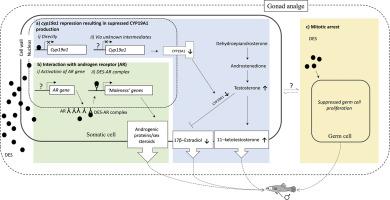Comparative Biochemistry and Physiology B: Biochemistry & Molecular Biology ( IF 1.9 ) Pub Date : 2020-07-22 , DOI: 10.1016/j.cbpb.2020.110468 Jawahar G Patil 1 , Nor Hakim Norazmi-Lokman 2 , Tzu Nin Kwan 3

|
Hormonal sex reversal can produce monosex fish stocks and provide insights into their gamity and reproductive physiology. However, paradoxical effects have been reported in several fish species that remain largely ignored as anomalies, particularly those of masculinisation. As a first step, this study examined reproductive viability of paradoxically masculinised Gambusia holbrooki produced following oral administration (20–100 mg/kg feed) of a feminizing hormone diethylstilbestrol (DES). Contrary to expectation, all treatment groups produced 100% male populations. Survival, mating behaviour, gamete production, breeding output as well as expression of anti-Mullerian hormone (amh), ovarian (cyp19a1a) and brain (cyp19a1b) aromatase of masculinised fish were also examined. Survival (≤ 54.1 ± 7.3%) at termination of DES treatment was significantly lower compared with controls (88.6 ± 4.3%) but remained unaffected post treatment. Gonopodium thrusting frequency (33 ± 9.8 per 10 min) was not significantly different to untreated males just as sperm abundance (3.9 ± 1.5 × 108/male) and their motility (88.6 ± 29.1%). Importantly, paradoxically masculinised fish mated with virgin females and produced clutch sizes (22 ± 4) and progeny survival (87.0 ± %) that were comparable to that of untreated males. Masculinised testes showed high amh and low cyp19a1a expression, a pattern resembling those of untreated males. Production of paradoxically sex-reversed males with a capability to produce viable offspring has not been reported previously in this or other fish species. The outcomes support a feed-back regulation of oestrogenic pathways in this viviparous fish and could be useful for ecological applications such as controlling invasive fish populations.
中文翻译:

己烯雌酚(DES)处理后产生反常男性化的Gambusia holbrooki的生殖活力。
激素性逆转可以产生单性鱼类种群,并提供有关其游戏性和生殖生理的见识。然而,据报导,在几种鱼类中,自相矛盾的影响在很大程度上仍被忽略为异常,特别是男性化的异常。第一步,这项研究检查了口服雌性雌二醇二乙基雌二醇(DES)后产生的反常男性化的Gambusia holbrooki的繁殖力。与预期相反,所有治疗组均产生100%的男性人群。存活,交配行为,配子产生,育种产量以及抗穆勒激素(amh),卵巢(cyp19a1a)和大脑(cyp19a1b)的表达还检查了男性化鱼类的芳香化酶。与对照(88.6±4.3%)相比,DES治疗终止时的生存率(≤54.1±7.3%)显着降低,但治疗后仍未受到影响。与未经治疗的雄性相比,淋巴腺的刺入频率(33±9.8 / 10分钟)与精子丰度(3.9±1.5×10 8 /男性)及其运动力(88.6±29.1%)没有显着差异。重要的是,与原始雌性交配的反常男性化鱼类产生的手掌大小(22±4)和后代存活率(87.0±%)与未经处理的雄性相当。男性化睾丸表现出高amh和低cyp19a1a表达,类似于未经治疗的男性。这种或其他鱼类以前尚未报道过具有相反性别的,具有逆境性的雄性的繁殖能力,这些雄性具有繁殖后代的能力。结果支持这种卵生鱼的雌激素途径的反馈调节,并且对于诸如控制入侵鱼种群的生态应用可能是有用的。











































 京公网安备 11010802027423号
京公网安备 11010802027423号